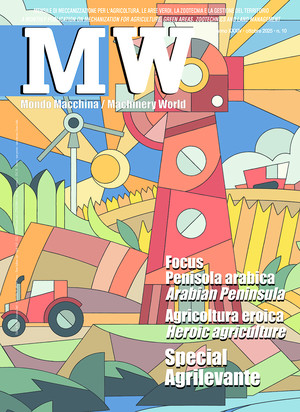
Agricultural machinery, market at top performance with the commodity uncertainty
Between January and August, sales grew in all the main markets. In Italy, tractor registrations were up 45% compared to 2020, driven by the digitalisation of the primary market. Raw material trends weigh on future trends
In the first eight months of the year, the world market for agricultuaral machinery reached record levels, recording significant increases in sales in all the main countries. Considering the tractor segment alone, the sector was driven by India where, between January and August this year, registrations reached 587 thousand units, up 35% compared to the same period last year. Top sales were also recorded in Turkey, where just under 39,000 vehicles were registered in the first eight months of 2021, an increase of 48.6% compared to 2020. Turkey's strong growth offsets the heavy downturn that penalised the agro-mechanical sector in the two-year period 2018-2019 when, after the peak reached in 2017 (about 73 thousand machines registered), sales more than halved. The US market was also in the black, albeit to a lesser extent.
From January to August, more than 218 thousand vehicles were registered in the USA, up 13% on 2020. Positive trends characterised the European markets. In Germany, cumulative sales in August since the beginning of the year stood at 23,000 units, up 8.5% compared to last year. Sales in Great Britain and Spain also grew, reaching 8,700 and 7,270 units respectively in the first eight months of the year. Compared to the same period in 2020, the British market grew by 26% and the Spanish market by 17%. According to CEMA, the European association of agricultural machinery manufacturers, the expansion trend is expected to continue in the coming months, but rising raw material prices and supply difficulties, partly due to restrictions imposed by the pandemic, could dampen growth.
Record increases in the Italian market. Italy also seems to be focusing more and more on agricultural mechanisation. Between January and August, tractor purchases boomed to over 16,500 machines, an increase of 45% compared to the same period last year. In the case of the Italian market, the surge in sales must be seen in the context of the digitalisation of the primary sector. What appears to be a real race for latest-generation technology is in fact dependent on the need to catch up with the new sustainability trend. The European Green Deal, the Next Generation EU and the new Common Agricultural Policy are pushing towards a rapid transformation of agriculture, which must reconcile productivity with environmental protection. This is only possible with the most advanced technologies, which are also needed to produce bio-energy, save water and slow down the process of soil impoverishment that makes it incapable of nourishing and growing crops.
The great challenge of sustainability. To protect ecosystems, humans are no longer enough: highly automated machines driven by artificial intelligence are needed. The agricultural machinery industry is now able to produce vehicles entirely controlled by computers, cameras and sensors, capable of analysing all the environmental parameters and ensuring the calibrated use of water, respect for the organic substance of the soil, and the scientific use of all production factors. While satellite systems read the terrain and make centimetre-accurate maps, fleets of drones record environmental data and monitor plants. Sophisticated computer systems independently manage the movements of machines in the field, and the huge flow of information collected is channelled through networks into specialised databases.
Raw materials alarm. The transformation of agriculture into a digital economy and the revival of the primary sector that comes with it are in danger of coming to a halt, however, because of a variable that has suddenly emerged, that of the price of ferrous and oil raw materials, which is rising uncontrollably and is weighing heavily on the production costs of agricultural machinery (manufactured mainly from steel, cast iron, iron and plastics). China has drastically reduced its exports of steel and ferrous materials and the purchase price of supplies for the agricultural machinery industry, both in Italy and abroad, has risen dramatically (in some cases by as much as 100%). In addition to ferrous materials, the situation regarding supplies for the manufacture of electronic components is very critical, which, at a time when 4.0 is growing so strongly, is a very dangerous braking factor. The problem is not only Italian, but concerns the agro-mechanical sector worldwide. However, it is precisely in Italy, a country that imports raw materials, that the consequences of this 'squeeze' could be particularly evident. It is estimated that the Italian industry in this sector (11.5 billion euro annual turnover, 70% of exported production, more than 1,500 companies with around 100,000 employees) will not be able to keep up with stocks beyond the middle of next year. The issue is of political importance for at least two aspects: the weakness of the national steel industry, which is increasingly dependent on foreign countries, and trade relations with China, which appear increasingly critical.








